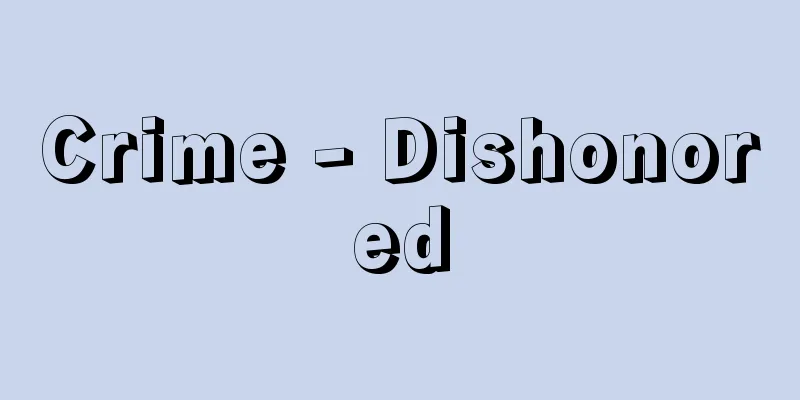Crime - Dishonored

|
It refers to an act that should be punished by a criminal offense. There are countless types of acts that are harmful to social life, but not all of them are considered crimes. Only those acts that are so harmful that they are declared by legislation to require the strong measure of criminal punishment are considered crimes. Not only the various acts prescribed in the Penal Code, but also acts that violate the Minor Offenses Act and other special laws, and administrative regulations such as the Road Traffic Act, are crimes as long as criminal penalties are prescribed for them. Therefore, violations of the Road Traffic Act, such as speed limits and parking violations, are no different from murder or theft in terms of crimes. [Haruo Nishihara] TransitionWhat is considered a crime, that is, what kind of acts are punishable by law, has varied considerably from era to era and from nation to nation. However, it can be said that acts that violate basic norms, such as murder, assault, theft, and rape, have been considered crimes and subject to punishment in almost every era and in every country in the world. However, many other crimes have continued to evolve with the times, reflecting the political and economic structures, customs, and habits of each nation. Moreover, in countries before the Enlightenment in the 18th century, the so-called arbitrary criminal and criminal law system ruled, and the exercise of the power to punish was left largely to those in power. As a result, what was considered a crime and what kind of acts were punishable by law were not always clearly stated. It was only after the French Revolution in Europe and after the old Criminal Code of 1880 (Meiji 13) in Japan that the principle of criminal and criminal legality was finally established, and it was decided that in order for the state to impose punishment, it must clearly state the crime and the punishment in law beforehand. [Haruo Nishihara] significanceThe word crime has various meanings. The first is crime as an actual entity, which refers to the actual event itself, such as A killing B. The second is crime as an individual concept, which refers to individual types of crime such as murder, injury, and theft. The third is crime as a general concept, which represents the highest universal concept that can encompass all types of crime. This third general concept of crime means that, for example, the individual fact of A injuring B in a car accident can be subject to compensation for damages as a tort under civil law, and subject to criminal punishment as a crime under criminal law. Furthermore, as will be explained later, in the strict sense of the term in criminal law, a crime refers to a culpable or illegal act, but there are cases where a mere illegal act is called a crime. For example, a crime committed by a mentally ill person. In this case, the act of a mentally ill person is not culpable, so it cannot be called a crime in the strict sense, but it is commonly said that the person has committed a crime in the sense of committing an illegal act. [Haruo Nishihara] conceptIn terms of content, a crime is a culpable or illegal act. First of all, a crime must be an "act." The subject of an act is limited to humans, and animal activity and natural phenomena themselves do not fall under the category of acts. Also, because an act must be something that can be controlled by will, physical reflex actions and actions under absolute coercion are excluded from the definition of an act. Furthermore, because an act refers to a person's external attitude, will or thought itself is not an act and does not constitute a crime. Next, a crime is an "illegal" act. Illegal means violating the norms of the Criminal Code, and what kind of acts violate the norms of the Criminal Code are described in both positive and negative terms in the constituent elements of each article of the Criminal Code and the grounds for excluding illegality in the General Provisions of the Criminal Code. Therefore, violation of norms, i.e. illegality, simultaneously means the absence of grounds for excluding illegality and the applicability of the constituent elements. Criminal law norms are intended to protect legal interests, that is, the important interests of the state, the public, or individual citizens, and therefore take the form of either a prohibition to "not infringe on a specific legal interest" or an order to "take actions that will protect a specific legal interest." Therefore, the substance of a norm violation, or illegal behavior, is limited to behavior that infringes or endangers a legal interest. Now, illegal acts can be classified from various perspectives: commission and omission, completion and attempt, principal and accomplice, one crime and several crimes. All of these have in common that they are illegal, but there are differences in the severity of the illegality, and therefore the severity of the punishment imposed. Finally, a crime is a "culpable" act. Whereas the assessment of the illegality of an act is a judgment of a violation of a norm or obligation, that is, a judgment of "should have done it but did not," the assessment of culpability is nothing more than a judgment from the perspective of possibility, that is, "could have done it but did not." Whereas the assessment of illegality is about the objective act, the assessment of culpability is about the subjective actor. Therefore, for example, circumstances such as the perpetrator being a criminal minor under the age of 14 or being mentally ill are facts that negate culpability. [Haruo Nishihara] kindsCrimes can be broadly divided into three types according to the nature of the legal interests, that is, the interests protected by law. The first type is crimes that harm the legal interests of the state, including treason, obstruction of public duties, harboring a criminal, perjury, violations of tax laws, and violations of the Anti-Subversive Activities Act. The second type is crimes that harm the public legal interests, including riot, arson, forgery, violations of various minor offense laws, and violations of the Road Traffic Act. The third type is crimes that harm the legal interests of individuals, including murder, assault, defamation, theft, embezzlement, and damage to property. [Haruo Nishihara] Crime PreventionCrime is an act that harms society and disturbs its order, so naturally, in every era and society throughout history, various measures have been taken in response to crimes that have occurred. Such specific measures are generally called crime policies. This has been done since before the emergence of nation states, and crime prevention measures were seen both inside and outside of tribes and village communities before the modern era. Wars were waged to prevent the invasion of external enemies, and sanctions were imposed on internal criminals for disturbing order. However, it was much later, and we had to wait for the development of science in the 19th century, before scientific crime prevention measures were taken. This is because in order to take better measures, it is necessary to explore the causes of crime and take rational measures based on those causes. Since the 18th century, especially in Europe, the development of natural science combined with humanitarianism due to the civil revolution, and research on the causes of crime, penalties, and even criminal treatment has developed. A similar term to crime prevention is criminal policy, which is a policy-making and policy implementation activity of the national or local government that provides guidelines for specific crime prevention measures based on legal theory and devises those measures. An example of policy implementation by local governments is the enactment of ordinances. In the field related to crime, most local governments have enacted nuisance prevention ordinances and youth development ordinances, and criminal policies are implemented according to the characteristics of the region. For example, criminal penalties may be imposed by ordinances on things such as molestation in cars, which the Criminal Code cannot apply to, and sexual acts with consenting persons under the age of 18. [Tadashi Moriyama May 21, 2018] Crime Prevention TargetsThe targets of crime prevention measures are not limited to acts that are subject to criminal punishment. Therefore, the concept of crime is broader than that under the Criminal Code, and includes socially harmful acts that are not subject to criminal punishment. "Socially harmful" does not simply mean that the acts cause a certain amount of damage to individuals, but also means that there is some kind of collective social backlash (such as criticism) against these acts, and the imposition of public sanctions is justified. The reason why the target acts of measures are not limited to crimes is, first of all, that measures against crime must also be able to respond to future situations. Even acts that are not currently subject to criminal penalties may well become socially problematic and subject to regulation in the future. Drug control is a typical example, where a specific drug that is not currently subject to regulation may become subject to regulation if it is recognized as socially harmful (for example, the synthetic drug MDMA was not subject to regulation in Japan until 1989). This phenomenon is usually called criminalization (see below). Secondly, acts that are not punishable by criminal law may be subject to regulation by other means. Examples of such acts include acts of suspected criminality by juveniles as a measure under the Juvenile Law, acts of prostitution under the Anti-Prostitution Law, and acts of insanity that lack criminal responsibility under the Criminal Law. Although these acts are not punishable by criminal law due to their nature, they need to be regulated because of their social harm. Acts of suspected criminality by juveniles include smoking, drinking, and wandering around at night, which are not a problem for adults, but from the perspective of healthy development of juveniles, they require measures such as guidance. In addition, when the Anti-Prostitution Law was enacted in 1956, prostitution was not punished because women who engaged in prostitution were perceived as victims of society, but it remains an act that disrupts sexual morals in society, and crime prevention measures are being taken. Furthermore, even when acts of insanity cannot be punished by criminal law, they are currently dealt with under the Mental Health and Welfare Law and the Law on Medical Observation of Insane Persons, etc. Thirdly, in recent years, there has been a debate about regulating minor nuisances that do not amount to crimes. This is because ordinary residents feel more anxious about nuisances that occur frequently on a daily basis than about serious crimes that are rarely encountered. In Europe and the United States, regulations on this type of behavior have been strengthened, as it is considered to reduce the quality of life (QOL). For example, in the UK at the end of the 1990s, legislation was enacted to regulate anti-social behavior that cannot be punished under the criminal law, such as late-night partying, drinking and drunkenness in public places, and vandalism against public property, and the regulations on nuisances have been strengthened and in some cases criminalized. Therefore, there is a global trend to expand the scope of crime prevention measures to include not only criminal acts but also anti-social behavior, nuisances, and misconduct that precede them. [Tadashi Moriyama May 21, 2018] Trends in criminal law and tougher penaltiesIn the past, Japan was cautious about new legislation and legal reforms, and no major movement was seen, but from the late 1990s to the 2000s, various laws with criminal penalties were enacted and amended one after another. In 1999, the Child Prostitution and Child Pornography Punishment Act, the Unauthorized Access Prohibition Act, the Organized Crime Punishment and Crime Proceeds Control Act, the Communications Interception Act, and the Organization Control Act were enacted, and in 2000, the Stalking Control Act, the Child Abuse Prevention Act, and the Intermediary Profit Punishment Act were enacted. In 2001, the Spousal Violence Prevention Act (DV Prevention Act) was enacted, and in 2003, the Picking Prevention Act, the Dating Site Control Act, and the Medical Observation Act for the Mentally Incompetent were enacted, and most of these have since been amended. As such, this period was called the era of criminal legislation, as criminal legislation was enacted one after another. These phenomena can be roughly called criminalization and severe punishment. These legislative and amendment movements also extended to the major juvenile and prison laws, which had hardly been amended at all; the former was amended in 2000, and the latter was replaced by the Prisoner Treatment Act in 2005 and the Criminal Detention Facilities Act the following year, which brought about major reforms to the juvenile and criminal justice systems. In addition, the Criminal Code was amended one after another to change the way crimes were handled, with the creation of new crimes of human trafficking and kidnapping, the addition of fines to theft, the creation of a new crime of driving a motor vehicle resulting in death or injury, and the transition to the Act on the Punishment of Driving a Motor Vehicle Causing Death or Injury. In 2017, the name and content of the crime of rape was changed in sexual crimes, and a new type (forced intercourse, etc.) was introduced to punish sexual acts against men and women against their will, with the punishment being made heavier at the same time. In special laws, the 2014 amendment to the Child Prostitution and Child Pornography Punishment Act criminalized the simple possession of child pornography, and a new Act on the Prevention of Revenge Pornography Victims was established, strengthening regulations in the area of human sexuality. The background to this is the protection of young people in society at large and the establishment of their right to sexual self-determination. However, these legislative and amendment moves have been criticized by some as harsher penalties and excessive criminalization. Basically, these trends are consistent with the tendency toward protecting victims and toward retribution in society in general, but the purpose of harsher penalties is not necessarily clear, and if the aim is to deter future crimes, it must be scientifically proven that harsher penalties have a crime-deterrent effect. However, at present, this has yet to be proven anywhere in the world in criminology or criminal policy. Furthermore, if it is about protecting victims or taking into consideration social sentiment, there is a sense of revenge, but modern society prohibits revenge by individual citizens, and there is a risk that this will go against this. As such, the movement toward criminalization and harsher penalties under new criminal legislation that has been ongoing since the 1990s is fraught with various problems, including restricting civil liberties and having a significant impact on the daily lives of the people, and it will be necessary to pay close attention to the impact of this legislation in the future. [Tadashi Moriyama May 21, 2018] Criminalization and decriminalizationThe standards of social harm change depending on the society and the era. Crime prevention measures must be modified accordingly. For example, an act that was not previously considered socially harmful may become harmful over time, and conversely, an act that was previously considered harmful may no longer be considered harmful. The former is a phenomenon called criminalization, and the latter is called de-criminalization. In modern society, there are overwhelmingly more examples of the former, but historically there are many examples of the latter. In the 1970s in the United States in particular, the call for decriminalization became stronger, and it was said that it was excessive for the state to intervene and impose penalties on acts that have no victims (victimless crimes), such as homosexuality and suicide, and that these should be left to the morality of ordinary citizens. Given today's movement to legally recognize same-sex marriage, the movement for decriminalization was natural, and from the perspective of the cost-benefit analysis of state intervention, it was also considered inappropriate in light of the state's financial situation. In Japan, adultery (Article 183) was a crime in the Criminal Code until just after World War II, but was abolished in the postwar revisions. This crime was originally intended to demonstrate the patriarchal domination of men by punishing only married women, and as a policy it was intended to boost the morale of married husbands on the battlefield. However, with the creation of gender equality provisions in the postwar constitutional revisions and changes in views of love, this purpose was quickly lost, and it was no longer a target for crime prevention measures. On the other hand, examples of criminalization can be found in the criminal legislation mentioned above. For example, the Stalking Prevention Act, enacted in 2000, criminalized acts such as stalking specific individuals that had previously been tolerated, and targeted stalking, which rapidly became a social problem following the murder of a female university student in Okegawa. However, it was limited to stalking behavior that arose from "romantic feelings or other feelings of affection toward a specific person, or feelings of resentment for not having those feelings fulfilled," and consideration was given to guaranteeing civil liberties such as media, political activities, and labor movements. In this way, crime prevention measures change according to the needs of society. [Tadashi Moriyama May 21, 2018] Punishment and criminal treatmentTraditionally, crime prevention measures have relied heavily on punishment and have focused on its execution. Since the 18th century, penal theory has been popular in Europe, and each country has enacted a criminal code based on this theory. One of the bases for this is the social contract theory, which states that citizens are born into an implicit contract with the state, and accept that they will be punished by the state if they commit a crime. In this way, the state's right to punish and the people's obligation to accept punishment were established. At the time, the main punishments were death penalty and corporal punishment, but with the development of the Industrial Revolution, attention was focused on the labor of criminals, and gradually the death penalty was replaced by imprisonment with forced labor. Later, corporal punishment was avoided as humanitarianism deepened, and as European countries gained colonies overseas, banishment and exile became more common. However, on the other hand, as social factors such as poverty began to be recognized as the causes of crime, the idea of detaining criminals in facilities to improve and rehabilitate them and allow them to return to society began to take root. The treatment of criminals became the center of crime prevention and penal policy, and this way of thinking continued, at least in Europe and the United States, until around 1970. However, around that time in the United States, the research of Robert Martinson (1927-1979) and others led to skepticism about the function of punishment in light of the high recidivism rate of released prisoners, and under the slogan "Nothing Works," a movement to abandon the idea of social rehabilitation gained momentum, and now prisons and other facilities are dominated by a method of simply detaining inmates based on the principle of retribution, without implementing social rehabilitation programs through labor or other means. However, as a result, prison sentences have become longer, and the number of inmates, including pretrial detainees, in the United States has exceeded 2.2 million in 2013, resulting in overcrowding in prisons and detention centers. However, in Japan, the idea of social rehabilitation is still deeply rooted, and the new Penal Detention Facility Act also includes the principle of treatment. However, the number of inmates in Japan's penal institutions is small, at about 55,000 in 2016, and in terms of the actual application of penalties, the overwhelming majority are fines, accounting for 90% of all penalties. [Tadashi Moriyama May 21, 2018] Victim supportAs can be seen from the above, traditional crime prevention measures were aimed at crimes or criminals. This was because it was thought that this would prevent future crimes. It was not until after World War II that interest in crime prevention began to be focused on victims and victims. During this period, victimology was born and an academic approach to victims was started, but initially, the topic of how victims were involved in the occurrence of crimes and what role they played was discussed. This was the debate over the so-called victim's culpability and fault. Later, in the 1960s, the need for victim relief was asserted worldwide, and the victim relief movement became active. This is because, while the idea of treating criminals and protecting their human rights were progressing in crime prevention, social understanding of the situation in which victims had long been ignored and not subject to protection or relief progressed. In Japan, too, momentum for victim relief grew from the 1970s to the 1980s, and in 1980 the Crime Victims Benefits Act was enacted as a symbol of this. Since then, various laws related to victims have been established in order to balance the treatment of criminals, and these laws continue to exist today. However, the significance of including victims in crime prevention measures is not limited to providing relief or protection, but is also important in the area of victim prevention, and taking into account the tendency of certain individuals or groups to become victims, that is, the characteristics of victims, and preventing victimization before it occurs is recognized as a modern-day way of preventing crime. For example, as the example of "bank transfer fraud" shows, it shows how important it is to respond to potential victims, such as by providing advice, in addition to dealing with perpetrators in crime prevention measures. [Tadashi Moriyama May 21, 2018] Crime prevention measuresTraditional crime prevention measures are based on ex post prevention, where police and other law enforcement agencies and criminal justice agencies wait for a crime or delinquency to occur before taking measures to remedy the situation. However, this type of response is, of course, premised on the social chaos that will result from an actual crime, particularly the occurrence of damage, and will necessitate the consumption of huge amounts of human and material resources, as well as expenditures on the national finances, including responses to criminals. This is where the idea based on ex post prevention theory, known as environmental criminology in the United States and situational crime prevention in the United Kingdom, was born. In the 1970s in the United States, as mentioned above, skepticism towards criminal treatment, "Nothing Works," spread, and the idea of preventing future recidivism through rehabilitation programs waned. Around the same time, this idea of preventive crime emerged. In other words, it is a method that is completely different from traditional crime prevention measures, and is based on prevention, aiming to make physical improvements by clarifying the mechanisms by which crime occurs at the scene. This method is characterized by the fact that it does not require huge budgets and that the daily efforts of each individual citizen can be a major force. The underlying idea is that "crime occurs due to opportunity." It is true that crimes occur at specific locations (hot spots). Therefore, crime prevention should not approach criminals, but rather the various opportunities that induce crime at hot spots and the physical environment at the scene. For example, snatch thefts tend to occur frequently in places with poor lighting and few people at night, but snatch thefts can be prevented to a certain extent by improving lighting at night. In addition, the automated ticket gates installed at many train stations also serve the secondary function of environmental criminology in reducing fare evasion (riding without paying). This type of approach attracted attention in the 1970s with the proposal of "Crime Prevention Through Environmental Design" (nowadays abbreviated as CPTED) by American criminologist Clarence R. Jeffery and architectural scholar Oscar Newman. Later, Ronald Clarke, a researcher at the British Home Office, developed the theory of situational crime prevention, which became the mainstream of crime prevention measures in the United States and the United Kingdom, where crime was rising sharply at the time. In fact, this idea has been introduced all over the world, and the structure of houses and buildings (burglary-proof housing), parking layouts, planting methods, and the installation of lighting and security devices have been reconsidered from the perspective of crime prevention. This idea first gained attention in Japan in the late 1990s when crime was on the rise, and today most local governments have enacted "safe and secure town planning ordinances" that incorporate the perspectives of environmental criminology or situational crime prevention. However, if this way of thinking goes too far, it can lead to the theory of "gated communities," where the entire town is fortified as a form of regional ego, collectively defending against intruders from the outside and isolating it from other areas.In fact, these types of newly developed residential areas are spreading throughout Western countries, and depending on how they are defined, there are said to be between 20,000 and 40,000 in the United States.In response to this, some American cities have ordinances that prohibit the development of this type of residential area, as gated communities divide the community. [Tadashi Moriyama May 21, 2018] Private crime preventionCrime prevention measures are generally implemented by national and local governments, but in reality, voluntary activities by residents are also essential for crime prevention activities. In Japan, in the 1990s, when there was a high incidence of residential burglaries such as lock-picking and sexual crimes targeting children on their way to school, this type of activity was organized nationwide, and daily community safety activities were carried out under the leadership of neighborhood associations and PTAs, with approximately 20,000 organizations nationwide as of 2017. Meanwhile, in response to this situation, the private security industry has also grown dramatically, with more than 8,000 companies as of 2017, and private homes, commercial facilities, and companies contract with security companies to ensure security. As such, there are limits to what the national and local government activities can accomplish in crime prevention alone, and there is growing recognition of the importance of private sector activities as a complement to this, leading to a trend toward privatization of crime prevention efforts. [Tadashi Moriyama May 21, 2018] Crime in a non-literate societyIn terms of the manner in which delinquency committed in a preliterate society is dealt with, there are two types: (1) delinquency that a society itself deals with using methods officially recognized by that society, and (2) delinquency that an individual who has been victimized deals with the perpetrator privately through his or her own efforts. If a crime is defined as a delinquent act that is punishable by official procedures, such as the death penalty, corporal punishment, or a fine, then in a preliterate society, such criminal acts include not only (1) but also (2). Many legal anthropologists have pointed out that it is inappropriate to understand delinquency in a preliterate society using legal concepts from a civilized society. Delinquency that falls under (1) is one that poses a danger to the order and peace of the society, and so the responsible party is punished by an officially recognized institution such as a council of elders, a judicial assembly, or a chief, thereby expressing the society's indignation and imposing sanctions on the perpetrator. The acts that are counted as such misconduct vary from tribe to tribe, but generally include breaking the incest taboo, practicing sorcery to harm other members of society through incantations, practicing witchcraft to bring harm through the use of supernatural powers, repeatedly committing tribal customs, insulting those who hold political or administrative authority in the society, and refusing to obey the orders of such people. (2) includes the act of the victim taking back what was stolen by force, or the victim taking action against the perpetrator by themselves. This method of self-help varies from tribe to tribe, but as we move from a pre-literate society to a civilized society, (2) is gradually suppressed, and a civil law is formed in which individuals can claim compensation for damages suffered through public procedures. In contrast, a criminal law is created that treats acts that disrupt the social order as crimes and imposes penalties, and the law is divided into two. [Toru Ariji] "Emori Goo, "Law and Moral" (included in "Human Society II: Contemporary Cultural Anthropology 4", 1960, Nakayama Shoten)" ▽ "Radcliffe Brown et al., edited by Chiba Masashi, "Introduction to Corporate Abnormology" (1974, Kobundo)" ▽ "Ogawa Taro, "Lecture on Criminal Policy, Volume 2" (1978, Hosei University Press)" ▽ "Nishihara Haruo, "Complete Works of Modern Law 36: Crime, 2nd Edition (1983, Chikuma Shobo)" ▽ "Danto Shigemitsu, "General of Criminal Law Guidelines" 3rd Edition (1990, Sobunsha)" ▽ "Ida Yoshiyoshi, "The Present and Purpose Acts of Criminal Theory" (1995, Seibundo)" ▽ "Yoshioka Kazuo, "Contemporary Law Course 29: Criminal Studies" (1996, Seibai Shoin)" ▽ "Okamoto Masaru, Criminal Theory and Criminal Law Thought" (2000, Shinzansha Publishing)" ▽ "Invitation to Criminology, 2nd Edition by Moriyama Masaru and Nishimura Haruo (2001, Nihon Hyoronsha)" ▽ "Takahashi Yoshiaki and Watanabe Kazumi, New Criminal Social Psychology, 2nd Edition (2004, Gakubunsha)" ▽ " Suzuki Shigetsugu, General Criminal Law, 2nd Edition (2011, Seibundo)" ▽ "Otani Minoru's "Lectures on Criminal Law" New Edition, 4th Edition (2012, Seibundo)" ▽ "Yamanaka Keiichi, General Criminal Law Thought" 3rd Edition (2015, Seibundo)" ▽ "Otani Minoru's "Lectures on Criminal Law" New Edition, 4th Edition, Supplementary Edition (2015, Seibundo)" ▽ "Otani Minoru's "Lectures on Criminal Law" New Edition, 4th Edition, Supplementary Edition (2015, Seibundo)" ▽ "Beginners Criminology" edited by Moriyama Masa and Kobayashi Hisaichi (2016, Seibundo)" ▽ "Beginners Criminal Policy edited by Moriyama Masa and Abe Tetsuo, 3rd edition (2017, Seibundo)" ▽ "Ministry of Justice's Criminal White Paper" edition (Ministry of Justice website)" [Reference items] | | | | | | Perjury | | | | | | law | | | | | | | | | | | | | | | | | Criminology | | | Criminal | law | Forgery | |Source: Shogakukan Encyclopedia Nipponica About Encyclopedia Nipponica Information | Legend |
|
刑罰を科せられるべき行為をいう。社会生活上有害な行為には無数の種類のものがあるが、そのすべてが犯罪とされるのではなく、そのうち有害の度合いが重大で、立法により刑罰という強い手段に訴える必要があると宣言された行為だけが犯罪となる。刑法に規定された各種の行為はもちろん、軽犯罪法その他の特別法や、道路交通法などの行政取締法規に違反する行為も、これに対して刑罰が規定されている限りは犯罪である。したがって、速度制限違反や駐車違反などの道路交通法違反も、犯罪という点では、殺人や窃盗と変わりがない。 [西原春夫] 変遷何を犯罪とするか、つまりどのような行為に対して刑罰を科すかは、各時代、各民族によってかなり違っていた。もっとも、殺人・傷害・強窃盗・強姦(ごうかん)などの基本的な規範に違反する行為は、ほとんどいつの世にも、また世界のどの国でも犯罪とされ、刑罰の対象とされていたといえよう。しかし、その他の多くの犯罪は、各民族の政治・経済機構や風俗・習慣などを反映し、時代の進展とともに生々発展を続けてきたのである。しかも、18世紀の啓蒙(けいもう)期以前の国家には、いわゆる罪刑専断主義が支配し、刑罰権の行使が大幅に権力者にゆだねられていた結果、何が犯罪であり、どのような行為に対して刑罰が科されるかが、かならずしも法律によって明示されていなかった。ヨーロッパにおいてはフランス革命以降、日本においては1880年(明治13)の旧刑法以降、ようやく罪刑法定主義が確立され、国家が刑罰を科すためには、あらかじめ犯罪と刑罰とを法律に明示しなければならないとされたのである。 [西原春夫] 意義犯罪ということばには、種々の意義がある。第一は実在としての犯罪であって、甲が乙を殺したというような現実のできごとそのものをさす。第二は個別類型的な概念としての犯罪であって、殺人・傷害・窃盗などの個々の犯罪類型を意味する。第三は一般的概念としての犯罪であって、すべての犯罪類型を包括しうる最高の普遍的概念を表すものである。この第三の犯罪という一般的概念があることによって、たとえば自動車事故で甲が乙に傷害を与えたという一個の事実が、一方において民法上の不法行為として損害賠償の対象となり、他方において刑法上の犯罪として刑罰の対象となることがわかる。 さらに、犯罪は、後述するように、刑法学上の厳密な意味では有責・違法な行為をさすのであるが、単なる違法行為を犯罪という場合がある。たとえば精神病者の犯罪というように。この場合、精神病者の行為は有責性を欠くから、厳密な意味では犯罪とはいえないが、違法行為を犯しているという意味で、俗に犯罪を犯したということがある。 [西原春夫] 概念犯罪は、内容的にいえば、有責・違法な行為である。犯罪はまず「行為」でなければならない。行為の主体は人に限られ、動物の活動や自然現象そのものは行為のなかには入らない。また、行為は意思によって支配しうるものでなければならないから、物理的な反射運動や絶対的強制下の行動は行為から除外される。さらに、行為とは人の外部的態度を意味するから、意思や思想そのものは行為でなく、犯罪にならない。 次に、犯罪は「違法な」行為である。違法というのは刑法規範に違反することであって、どのような行為が刑法規範に違反するかは、刑法各本条の構成要件と、刑法総則の違法阻却事由とに積極・消極両面から記述されているから、規範違反性すなわち違法性は、同時に、違法阻却事由の不存在と構成要件該当性を意味する。 刑法規範は、法益すなわち国家、公共、または国民個人の重要な利益を守るためのものであるから、「特定の法益を侵害するな」という禁令か、「特定の法益を守るような行動をとれ」という命令かのどちらかの形をとる。したがって、規範違反すなわち違法な行為の実質は、法益を侵害し、またはこれを危険に陥れる行為に限定される。 ところで、違法な行為は種々の観点から分類することができる。作為犯と不作為犯、既遂と未遂、正犯と共犯、一罪と数罪。これらはどれも違法である点では共通するが、違法性の重さの点ではそれぞれに相違があり、したがって科せられる刑の重さも違ってくる。 最後に、犯罪は「有責な」行為である。行為に対する違法性の評価が規範違反または義務違反、すなわち「すべきであったのにしなかった」という判断であるのに反して、有責性の評価は「しえたのにしなかった」という、可能性の面からする判断にほかならない。違法性の評価では客観的な行為が問題となるのに反して、有責性の評価では主観的な行為者が問題となってくる。したがって、たとえば犯人が14歳未満の刑事未成年者であるとか、精神病者であるとかの事情は、有責性を否定する事実ということになる。 [西原春夫] 種類犯罪は、法益すなわち法律の保護する利益の性質ごとに大別すると3種に分かれる。第一は国家の法益を害する犯罪であって、内乱罪・公務執行妨害罪・犯人蔵匿罪・偽証罪・税法違反・破壊活動防止法違反などがこれに属する。第二は公共の法益を害する犯罪であって、騒乱罪・放火罪・文書偽造罪・各種の軽犯罪法違反・道路交通法違反などがこれに含まれる。第三は個人の法益を害する犯罪であって、殺人罪・傷害罪・名誉毀損(きそん)罪・窃盗罪・横領罪・器物損壊罪などがこれに入る。 [西原春夫] 犯罪対策犯罪は社会に害悪を与え、その秩序を乱す行為であるから、当然ながら、歴史的にみてどの時代、どの社会でも、発生した犯罪に応じて種々の対策を講じてきた。このような個別具体的な措置を一般に、犯罪対策crime policyとよんでいる。これは国家発生以前から行われてきたのであり、近代以前の部族や村落共同体の内外においても犯罪対策はみられた。外部の敵に対してはその侵入を防ぐために戦争を行い、内部の犯罪者に対しては秩序を乱すとして制裁が加えられてきた。しかしながら、科学的な犯罪対策が講じられるようになるのは、かなり後のことであり、19世紀における科学の発達を待たねばならなかった。よりよい対策を講じるためには、犯罪の原因を探求し、それに基づいて合理的な対策をとる必要があるからである。18世紀以降、とくにヨーロッパにおいて、自然科学の発達と市民革命による人道主義とが相まって、犯罪原因論や刑罰論、さらには犯罪者処遇論の研究が発展してきた。 なお、犯罪対策と類似の用語として刑事政策があるが、これは法理論に依拠して個別具体的な犯罪対策のあり方に指針を与え、その措置をくふうする国家ないし地方公共団体の政策立案・政策実施の活動である。地方公共団体の政策実施の例としては、条例制定がある。犯罪にかかわる分野では、ほとんどの地方公共団体で迷惑防止条例や青少年育成条例が制定され、地域の特色に従った刑事政策が実施されており、たとえば刑法が適用できない車内痴漢や同意ある18歳未満の者への性的行為などに対して条例により刑罰が適用される場合がある。 [守山 正 2018年5月21日] 犯罪対策の対象犯罪対策の対象となるのは、刑罰が科される行為に限らない。したがって、刑法上の犯罪概念よりも広く、刑罰の科されない社会的に有害な行為を含む。「社会的に有害」とは、行為が単に個々人に一定の被害をもたらしているというだけでなく、これらの行為に対する何らかの集団的な社会的反動(批判など)がみられ、また公的な制裁を科すことが正当化される場合をいう。 対策の対象行為が犯罪に限らないのは、第一に、犯罪対策が将来の状況にも対応しなければならないためである。現在、刑罰が科されていない行為でも将来、社会的に問題となり、規制の対象になることは十分に考えられる。薬物対策がその典型例であり、現在規制の対象となっていない特定薬物が社会的に有害と認識されるようになると、規制対象とされることがある(たとえば、合成麻薬MDMAは、日本では1989年まで規制の対象とされていなかった)。このような現象は通常、犯罪化(後述)とよばれる。 第二に、刑罰をもって対応していない行為も刑罰以外の手段で規制の対象とする場合がある。この例としては、少年法の措置としての少年による虞犯(ぐはん)行為、売春防止法の売春行為、刑法上の責任能力に欠ける心神喪失中の行為などがある。これらの行為はその性質上刑罰は科されないが、社会的な有害性という意味では規制が必要である。少年の虞犯行為には、成人ではまったく問題とならない喫煙、飲酒、深夜徘徊(はいかい)などが含まれるが、少年の健全育成という観点では補導などの対応が必要である。また、売春行為は、1956年(昭和31)の売春防止法成立当時、売春を行う女性に対しては、むしろ社会の被害者であるという認識があったため、刑罰が科されなかったが、社会における性風俗を乱す行為であることには変わりなく、犯罪対策が講じられている。さらに、責任無能力の行為で刑罰を科すことができない場合でも、現に、精神福祉保健法や心神喪失者等医療観察法などで対応されている。 第三に、近年、犯罪には至らない軽微な迷惑行為に対する規制が議論されている。なぜなら、一般住民からすれば、めったに遭遇しない重大な犯罪よりも、日常的に頻発する迷惑行為のほうが不安感を強く感じるからである。欧米ではこの種の行為は「生活の質(クオリティ・オブ・ライフquality of life:QOL)」を低下させるものとして、規制が強まっている。たとえば、イギリスでは1990年代終わりに、深夜のドンチャン騒ぎ、公共の場の飲酒・酩酊(めいてい)、公共物に対するバンダリズム(破壊行為)など刑法で処罰できないような反社会的行動anti-social behaviourを規制する立法措置がとられ、迷惑行為の規制強化、場合によっては刑罰化が図られている。そこで、世界的に犯罪対策の対象を犯罪行為だけでなく、その前段階の反社会的行動、迷惑行為、不品行に拡大する傾向にある。 [守山 正 2018年5月21日] 刑事立法の動向と厳罰化従来、日本では新たな立法や法改正には慎重であって、大きな動きはみられなかったが、1990年代後半から2000年代にかけ、刑罰を伴うさまざまな法令が相次いで立法され、改正されている。1999年(平成11)には、児童買春児童ポルノ処罰法、不正アクセス禁止法、組織的犯罪処罰・犯罪収益規制法、通信傍受法、団体規制法、2000年(平成12)にはストーカー規制法、児童虐待防止法、あっせん利得処罰法が立法化されている。2001年に配偶者暴力防止法(DV防止法)、2003年にピッキング対策法、出会い系サイト規制法、心神喪失者等医療観察法などが続き、その後、これらのほとんどが改正されている。このように、この時期、刑事立法が相次いだため、刑事立法の時代などともよばれた。これらの現象は、おおむね犯罪化・重罰化とよぶことができる。 このような立法、改正の動きは、ほとんど改正されることがなかった主要な少年法、監獄法にも及び、前者は2000年に改正され、後者は2005年受刑者処遇法に、翌年には刑事収容施設法へと切り替わり、これらによって少年司法制度、刑事司法制度に大改革がもたらされた。また、刑法改正においても次々と犯罪対応の改変が行われ、人身売買罪・略取誘拐罪の新設、窃盗罪への罰金刑の追加、自動車運転致死傷罪の新設、さらにはこれの自動者運転死傷行為処罰法への移行などが続き、2017年には性犯罪において強姦罪の名称と内容が変更され、その意に反した男女を対象とする性行為を処罰する新類型(強制性交等罪)が導入され、同時に重罰化された。特別法においても2014年、児童買春児童ポルノ処罰法の改正では児童ポルノの単純所持を犯罪化し、新たにリベンジポルノ被害防止法が新設されるなど、人間の性に関する領域で規制が強まっている。この背景には、一般社会における青少年の保護、性的自己決定権の確立が看取される。 しかしながら、これらの立法や改正の動きは厳罰化や過度の犯罪化として一部批判を受けている。基本的にこれらの動向は、被害者保護ないしは一般社会の応報化の傾向と合致するものであるが、しかし、厳罰化の趣旨はかならずしも明確ではなく、将来における犯罪の抑止を目ざすというのであれば、厳罰化が犯罪抑止の効果をもたらすことを科学的に証明しなければならない。しかし、現在のところ、犯罪学や刑事政策では世界的にみてその証明は依然なされていない。また、被害者保護ないしは社会感情への配慮というのであれば、復讐(ふくしゅう)的な意味合いがあるが、近代社会は個々の市民の復讐を禁じており、これに逆行するおそれがある。 このように、1990年代から続いている刑事新立法の犯罪化、厳罰化の動きは市民的自由を制約し、国民の日常生活に重大な影響を及ぼすなど種々の問題をはらんでおり、今後、立法の影響に注目する必要がある。 [守山 正 2018年5月21日] 犯罪化と非犯罪化社会的有害性の基準は、社会によっても時代によっても変化する。これに応じて犯罪対策も改変する必要がある。たとえば、従来社会的に有害でないとされた行為が時代の経過とともに有害とされる場合、逆に、有害とされた行為が有害とされなくなる場合もある。前者がいわゆる犯罪化criminalization、後者が非犯罪化de-criminalizationとよばれる現象である。現代社会では、圧倒的に前者の例が多いが、歴史的には後者の例も少なくない。とくに1970年代のアメリカでは非犯罪化の主張が強まり、同性愛や自殺など被害者のいないような行為(被害者なき犯罪)にまで国家が介入し刑罰を科すことは過剰であり、一般市民のモラルにゆだねるべきとされた。今日の同性婚を法的に承認する動きからすれば、非犯罪化の動きは自然であり、また国家介入によるコスト・ベネフィット(費用・便益分析)の観点からも、国家財政状況に照らして不適当とされたのである。日本では、第二次世界大戦直後まで刑法に姦通罪(183条)が規定されていたが、戦後の改正で廃止された。この罪は、もともと婚姻中の女性のみを処罰するという男性の家父長的支配を示し、また政策的には婚姻中の夫の戦場における士気を高めることを目的としたが、戦後の憲法改正における男女平等規定の創設と恋愛観の変化に伴い、その使命が急速に失われたことで、犯罪対策の対象から外れたのである。 他方、犯罪化の例は上述の刑事立法のなかにみることができる。たとえば、2000年に成立したストーカー規制法は、従来放任されてきた特定個人に対するつきまとい等の行為を犯罪化するもので、桶川(おけがわ)女子大生殺人事件を契機に急速に社会問題化したストーカー行為を規制対象とした。しかし、「特定の者に対する恋愛感情その他の好意の感情又はそれが満たされなかったことに対する怨恨(えんこん)の感情」から生じたストーカー行為に限定され、マスコミや政治活動、労働運動などの市民的自由を保障するように配慮されている。このように、社会のニーズに応じて犯罪対策は変化する。 [守山 正 2018年5月21日] 刑罰と犯罪者処遇犯罪対策は従来刑罰に大きく依存し、その執行を中心に展開してきた。18世紀以降、ヨーロッパでは刑罰論が盛んになり、この議論に基づいて刑法典が各国で制定された。その根拠の一つが社会契約説であり、これによれば、国民は生まれながらにして暗黙のうちに国家と契約しており、犯罪を行えば国家による刑罰を受けることを承認しているとされ、このようにして国家刑罰権と国民の刑罰受認義務が確立した。刑罰の内容としては、当時死刑や身体刑が中心であったが、産業革命の発展とともに犯罪者の労働力が注目され、しだいに、死刑から強制労働を伴う拘禁刑へと転化した。その後、人道主義の深化により身体刑も回避され、ヨーロッパ諸国が海外に植民地をもつようになると追放刑、流刑が発達した。しかしながら、他方で犯罪原因として貧困などの社会的要因が着目されるようになるにつれて、犯罪者を施設に拘禁して改善・更生させ社会復帰を図る思想が芽生え、犯罪者の処遇は犯罪対策や刑事政策の中心となり、少なくとも欧米では1970年ごろまでこの考え方は続いた。 しかしながら、そのころ、アメリカではマーティンソンRobert Martinson(1927―1979)らの研究によって刑務所出所者の再犯率が高いことにかんがみ、刑罰の機能に対する懐疑論が生まれ、「Nothing Works(何も機能していない)」というスローガンのもとに、社会復帰思想をやめる動きが盛んになり、現在では、刑務所などの施設では、労働などを通じた社会復帰プログラムを行わず、応報原理に基づいて単に拘禁だけ行う方式が主流となっている。しかし、この結果、拘禁刑の長期化が進み、全米で未決拘禁者を含む収容者が2013年で220万人を超えるなど刑務所・拘置所の過剰拘禁が続いている。 もっとも、日本では、依然社会復帰思想が根強く、新しい刑事収容施設法においても処遇の原則が盛り込まれた。ただし、日本の刑事施設収容者数は2016年で約5万5000人と少なく、実際の刑罰適用では、罰金刑の適用数が圧倒的に多く、刑罰全体の9割を占める。 [守山 正 2018年5月21日] 被害者対策上記からも理解されるように、従来の犯罪対策は、犯罪ないしは犯罪者に対するものであった。これによって将来の犯罪を防止できると考えられたからである。犯罪対策において被害や被害者にも関心が寄せられるようになるには、第二次世界大戦後を待たねばならなかった。この時期、被害者学が誕生し、被害者に対する学問的アプローチが開始されたが、当初は、被害者が犯罪発生にどのように関与し、どのような役割を演じたのかが議論された。いわゆる被害者の有責性、落ち度をめぐる議論である。その後、1960年代には、世界的に被害者の救済の必要性が主張されるようになり、被害者救済運動が活発になった。これは、犯罪対策において、一方で犯罪者の処遇思想やその人権保障が進展しているのに対して、被害者は保護や救済の対象外におかれ、長く無視されてきた状況に対する社会的理解が進んだためである。日本でも、1970年代から1980年代にかけて、被害者救済の機運が高まり、1980年にはその象徴として犯罪被害者等給付金支給法が成立した。その後も、犯罪者処遇との均衡から、被害者に関連するさまざまな法令が設けられ、今日に至っている。 もっとも、犯罪対策の対象に被害者を含める意義は、単に救済や保護にとどまらず、被害予防の領域でも重要になっており、特定個人・集団が被害にあいやすい傾向、つまり被害者特性にかんがみ、被害を未然に防ぐことも犯罪を防止する点で現代的意義が認められる。たとえば、「振り込め詐欺」の例が示すように、犯人側への対応と同時に、潜在的な被害者側に対する助言などの対応が犯罪対策上、いかに重要であるかを物語っている。 [守山 正 2018年5月21日] 犯罪予防対策従来の犯罪対策は事後予防であり、犯罪・非行の発生を待って、警察をはじめとする法執行機関、刑事司法機関が善後措置を講じてきた。しかし、このような対応はいうまでもなく、現実に発生した犯罪がもたらす社会的混乱、とくに被害の発生を前提にしており、犯罪者への対応を含めて、膨大な人的物的資源の消費、国家財政の支出を余儀なくする。そこで誕生したのが事前予防論に根拠をおく、アメリカでは環境犯罪学、イギリスでは状況的犯罪予防論とよばれる考え方である。 1970年代アメリカでは、上述のように、犯罪者処遇への懐疑論「Nothing Works」が広まり、社会復帰プログラムによって将来の再犯を防止するという考えが衰退したのと前後して、このような事前予防論の考え方が台頭した。すなわち、従来の犯罪対策とまったく異なり、現場の犯罪発生メカニズムを解明することによって物理的な改善を図る方法であり、未然予防を基本とする。この手法は、膨大な予算を使うことなく、また国民ひとりひとりの日常的努力も大きな勢力になる点が特色である。その根底にある思想は、「犯罪は機会によって発生する」というものである。確かに、犯罪発生地点は特定場所(ホット・スポット)に集中することが知られる。したがって、犯罪対策は犯罪者にアプローチするのではなく、ホットスポットにおける犯罪誘発的な種々の機会、現場の物理的環境に対してアプローチすべきとされる。たとえば、ひったくりは夜間照明が乏しい人通りの少ない地点に多発する傾向があるが、これに対し夜間照明の改善を行うことによって一定程度ひったくりを予防することができる。また、多くの鉄道駅に設置されている自動改札機も副次的に不正乗車(キセル乗車)を減らす環境犯罪学の機能を果たしている。 このような手法は、1970年代アメリカの犯罪学者ジェフリーClarence R. Jefferyや建築学者ニューマンOscar Newmanの提唱する「環境設計による犯罪予防Crime Prevention Through Environmental Design(今日では、略してCPTED(セプテッド)ともよばれる)」で注目され、その後、イギリス内務省の研究官であったクラークRonald Clarkeが状況的犯罪予防論を展開して、当時犯罪が激増したアメリカ、イギリスの犯罪対策の主流となったのである。現に、世界各地でこの考え方が導入され、住宅・ビルの構造(防犯住宅)、駐車場の配置、植裁の方法、照明や防犯機器の設置などが、犯罪予防の観点から再検討された。 日本でこの考えが注目されるようになったのは、犯罪が増加した1990年代後半であり、今日、ほとんどの自治体で施行されている「安全・安心まちづくり条例」には、環境犯罪学ないしは状況的犯罪予防の視点が含まれている。 もっとも、この考え方が過度に進むと、地域エゴとして街全体を要塞(ようさい)化し、外部からの侵入者を集団で防御し、他の地域との隔絶を図るゲーテッド・コミュニティGated Community論に至るおそれがあり、現に欧米諸国でこの種の新興住宅街が各地に広がっており、その定義にもよるが、その数は全米では2万とも4万ともいわれる。これに対して、アメリカの都市によってはゲーテッド・コミュニティは地域を分断するものとして、条例でこの種の住宅街の開発を禁止しているところもある。 [守山 正 2018年5月21日] 民間の犯罪対策犯罪対策は国や地方公共団体で行われるのが一般的であるが、現実には犯罪予防活動においては住民の自発的な活動も欠かせない。日本においては、とくにピッキング被害などの住宅侵入盗や通学路の子供をねらった性犯罪が多発した1990年代に、この種の活動が全国的に組織され、町内会やPTAなどが主導して、日々の地域安全活動が展開されており、2017年の時点で、全国に約2万団体を数える。他方、このような状況に応じて、民間の警備産業も飛躍的に成長し、2017年の時点で8000社を超え、個人の住宅や商業施設、企業では、警備会社と契約し、セキュリティを確保している。 このように、犯罪対策は国や地方公共団体の活動だけでは限界があり、これを補完するものとして民間活動の重要性の認識が高まっており、いわば犯罪対策の民営化が進んでいる。 [守山 正 2018年5月21日] 無文字社会の犯罪文字のない社会で犯された非行を処理する態様からみた場合に、(1)ある社会自体が当該社会によって公認された処理方法で対応する非行と、(2)被害を受けた個人が自分の力によって加害者との間で私的に処理する非行の二つがある。 文明社会で、公的な手続を通して死刑、身体刑、罰金刑などの刑罰が科せられる非行をもって犯罪というのであれば、そのような犯罪行為は、文字のない社会では、(1)だけでなく、(2)も含まれる。そこで、文字のない社会の非行について、文明社会の法概念でもって理解するのは不適当であることが多くの法人類学者によって指摘されている。(1)に入る非行は、その社会の秩序や平穏を損なう危険があるために、長老会議、裁判集会、首長(しゅちょう)などの公認された機関で責任者に処罰を加え、当該社会の憤りを表すと同時に、加害者に制裁を加えるものである。このような非行に数えられる行為は部族によって異なるが、近親相姦禁忌(インセスト・タブー)を破る行為、他の社会成員にまじないによって害を与える邪術sorceryを行使する行為、また、超自然力を借りて害をもたらす妖術(ようじゅつ)witchcraftを行使する行為、部族慣行を反復して犯す行為、その社会の政治的・行政的権威を担う人を侮辱する行為、そのような人の命令に服従しない行為などが、概して含まれる。 (2)に含まれるのは、被害者が奪われた物を実力で取り返す行為、あるいは被害者の側が自分たちの手で加害者を処罰する行為である。この自力救済の仕方は部族によって異なるが、文字のない社会から文明社会に移るに応じて、(2)はしだいに抑制され、個人は公の手続を通して、受けた損害の賠償を請求できる民事法が形成される。これに対して、社会秩序を乱す行為は犯罪として刑罰が科せられる刑事法が構成され、法が二つに分化する現象が生じる。 [有地 亨] 『江守五夫「法と道徳」(『人間の社会Ⅱ 現代文化人類学4』所収・1960・中山書店)』▽『ラドクリフ・ブラウン他著、千葉正士編訳『法人類学入門』(1974・弘文堂)』▽『小川太郎著『刑事政策論講義 第2分冊』(1978・法政大学出版局)』▽『西原春夫著『現代法学全集36 犯罪各論』第2版(1983・筑摩書房)』▽『団藤重光著『刑法綱要総論』第3版(1990・創文社)』▽『井田良著『犯罪論の現在と目的的行為論』(1995・成文堂)』▽『吉岡一男著『現代法律学講座29 刑事学』新版(1996・青林書院)』▽『岡本勝著『犯罪論と刑法思想』(2000・信山社出版)』▽『守山正・西村春夫著『犯罪学への招待』第2版(2001・日本評論社)』▽『高橋良彰・渡邉和美著『新犯罪社会心理学』第2版(2004・学文社)』▽『鈴木茂嗣著『刑法総論』第2版(2011・成文堂)』▽『大谷實著『刑法講義総論』新版第4版(2012・成文堂)』▽『山中敬一著『刑法総論』第3版(2015・成文堂)』▽『大谷實著『刑法講義各論』新版第4版補訂版(2015・成文堂)』▽『守山正・小林寿一編著『ビギナーズ犯罪学』(2016・成文堂)』▽『守山正・安部哲夫編著『ビギナーズ刑事政策』第3版(2017・成文堂)』▽『法務省『犯罪白書』各年版(法務省HP)』 [参照項目] | | | | | | | | | | | | | | | | | | | | | | | | | | | | | | | | | | | | |出典 小学館 日本大百科全書(ニッポニカ)日本大百科全書(ニッポニカ)について 情報 | 凡例 |
>>: Khansā' (English spelling)
Recommend
Metal - kinzoku (English spelling) metal
Generally, it is a general term for a substance t...
Tadmar
…The ruins are located about 200 km northeast of ...
Peddler - Gyosho
A business method in which goods are carried arou...
Chile earthquake - Chilean earthquake
Earthquakes in South America, Chile. Huge earthqu...
Hamburgische Dramaturgie (English spelling)
...It was mainly drama analysis, and rather than ...
Waterhouse-Friderichsen syndrome
...After the onset of symptoms similar to upper r...
Adventures of Huckleberry Finn
A novel by Mark Twain. The British edition was pub...
primary commodities
…Generally, primary commodities refer to agricult...
Negative catalyst
A substance that acts on a reaction system to slow...
Smoke generator - Hatsuenzai
A chemical that undergoes a chemical reaction at r...
Avoidance - Avoidance
…In the old Chinese legal system, a system was in...
Girl Scouts
A movement centered on educating girls, founded in...
Solar cell - taiyodenchi (English spelling) solar cell
An element that converts sunlight energy directly...
Journal du voleur (English)
...Cocteau, JP Sartre, F. Mauriac, P. Claudel and...
Tsugaru Peninsula - Tsugaru Peninsula
A peninsula that juts out north from the western ...





![Cebu [island] - Cebu](/upload/images/67cc06411527c.webp)



